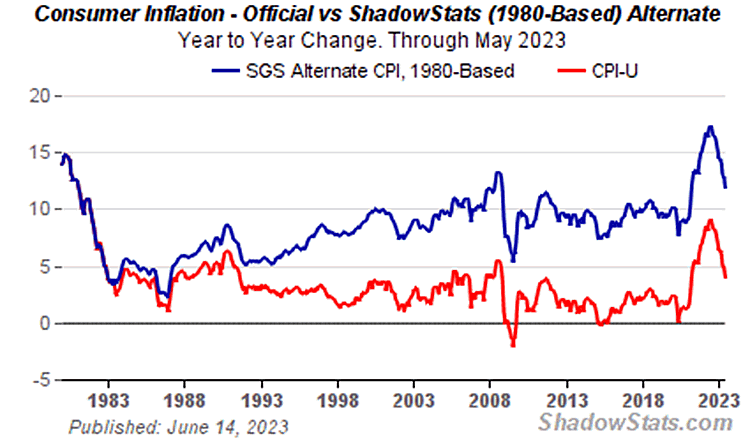You Won’t Believe Paul Krugman’s Latest Inflation Metric…
 Bullion.Directory precious metals analysis 22 September, 2023
Bullion.Directory precious metals analysis 22 September, 2023
By Peter Reagan
Financial Market Strategist at Birch Gold Group
Despite his accolades, Krugman has made some wildly inaccurate forecasts.
For example, he claimed in 1997 that the Internet’s impact on the economy would be about the same as the fax machine. In 2012, he said the euro would collapse “in a matter of months, not years.”
I can forgive him for failed economic projections – I’m not sure my track record is any better. After all, as Yogi Berra said, “It is difficult to make predictions, especially about the future.”
I’m sitting down at my keyboard today not to berate Krugman for inaccurate forecasts.
Instead, we’re going to discuss Krugman’s shameless and transparent efforts to convince us that Bidenomics really has been a success.
After all, he has data! What are you going to believe, the data or your lying eyes?
The invention of Krugflation
Krugman is the namesake for the made-up term “Krugflation,” which I define as:
A coastal liberal elite torturing economic data until it screams in an attempt to support a political agenda.
Here’s a perfect and recent example:
See, all we have to do is exclude the three most necessary household expenditures – food, energy (gasoline plus utilities) and shelter – and poof! Inflation is gone.
(He left used cars out, too, because their prices have risen 40% since the pandemic panic.)
If you read the responses to Krugman’s post, you’ll see people are having none of it. This time, he went a little too far – he tortured the data until it broke.
So what’s the point?
Why waste time playing games like this?
It mostly boils down to partisan politics.
First off, Krugman follows the Keynesian economic school of thought, which holds that money-printing and government handouts are the best way to create economic growth. Keynes actually said:
“The government should pay people to dig holes in the ground and then fill them up.”
Second, Krugman is a liberal. He’s cheerleading the White House’s Bidenomics success story. Even though the economic reality for millions of hard-working Americans is that they’re significantly worse off.
Reality:
- A $5,600 annual pay cut thanks to inflation
- Primary residence costs are up 16% (and rent payments are up about 25%)
- Food at home is up 20%
- Electricity prices are up 21%
- Gasoline prices are up 72%
Krugman’s political bias is not a secret. Back in 2016, as The National Review tells us:
Paul Krugman, who warned shortly after the 2016 election that Trump’s victory would trigger a global recession “with no end in sight.”
And he has kept this going all year:
February 11: Paul Krugman expects a global recession this year, warns “we don’t have an effective response.”
August 1: “Why Was Trumponomics a Flop?”
August 15: “From Trump Boom to Trump Gloom”
September 5: “Trumpism Is Bad for Business”
October 3: “Here Comes the Trump Slump”
October 24: “The Day the Trump Boom Died”
Look at the titles of those columns and tell me the man doesn’t have an agenda!
He recently took to CNN to explain how wrong Americans are about their own rising expenses. He blames economic pessimism on political affiliation:
This is what passes for economic analysis?
Inflation reports used to be an economic data point
To quote Ron Paul from May 2022, when even the “official” CPI was accelerating to historic levels not seen in 40 years:
I don’t pay much attention to those CPI reports because they don’t reflect my reality. I do, however, watch my personal expenses. And I hear from everyday Americans, folks just like you, who’re telling me their bills are up anywhere from 10-14% compared to a year ago.
How can that be? If CPI is +8.3% how can families have 10% higher expenses? Somebody’s not telling the truth.
Ron went on to explain two key ways that the Bureau of Labor and Statistics (BLS) tells a “white lie” whenever they report inflation numbers…
1. Home Price Inflation: Back in the 1970s and 80s, BLS inflation measurements factored in home prices.[…] But then, in 1983, they changed the way they measured how much people spend on housing. Instead of considering actual, real data like home prices, they came up with a completely hypothetical number called “homeowner’s equivalent rent of residences.”
2. Hedonic Quality Adjustments: If the BLS decides that something you buy, let’s say cars, are better than they were last year, but the price didn’t change? They’ll say you got more for your money this year – so the measured price of cars would go down in the BLS index, even though the price didn’t actually change!
Throughout most of human history, from Hammurabi to Ronald Reagan, inflation was measured by examining the price of a fixed basket of goods and services. If the prices went up, that was counted as inflation.
Then, in 1983, politics intervened.
Government officials started tinkering with inflation measurements because the cost-of-living adjustments (COLA) they had to pay Social Security recipients was getting unaffordable.
So they fudged the numbers.
Why? Because that was way easier than actually fixing the problem!
This article by John Williams explains in great detail. Here’s a summary:
The Chained-CPI (C-CPI) is a fully-substitution-based version of the CPI-U, which is the primary inflation measure published by the U.S. government’s Bureau of Labor Statistics. The C-CPI is designed to reduce the level of reported inflation that otherwise would be used by individuals to make decisions tied to their investments and income. As a vehicle for artificially reducing COLA adjustments for such programs as Social Security, its proposed use here appears to be a rare area of agreement between both sides in the current budget-deficit negotiations. [emphasis added]
The left and the right can’t agree on much – except, according to Williams, on colluding to rob Social Security recipients.
If we go back to the fixed-basket-of-goods inflation measurement, we see that today’s inflation is much worse than the official numbers (let alone Krugflation). The blue line on the Shadowstats graph represents increased cost of living – the real inflation rate as it should be reported:

via Shadowstats
If you look closely, you can see the exact point where the “official CPI” (red line) and the more accurate inflation rate (blue line) diverge on the graph above (roughly 1983).
Today’s CPI numbers are already wildly inaccurate, completely out of touch with reality. But Paul Krugman’s “analysis” pushes beyond merely out of touch with reality into the land of complete and utter fantasy.
Let’s not mistake partisan cheerleading for serious economic analysis – now matter how many prizes the man has won, or how many books he’s written.
YOU are the only expert on your finances
I believe you have a firmer grasp how much your expenses have risen since the pandemic panic than the Bureau of Labor Statistics, the Fed or even such a brilliant economist as Dr. Krugman.
Tell me your expenses are going up and I’ll believe you. I’m not going to argue with you, or wave a chart in your face.
Tell me you’re worried about the economy and I’ll agree.
Say you’re concerned about your financial future and I’ll sympathize.
The good news is, you still have one way to diversify your savings against both inflation and economic downturns. Since 1971 physical gold has handily outperformed inflation. Our education page has more information.
Along with other inflation resistant investments, physical precious metals like gold and silver could help preserve your retirement savings, maintain your buying power, and even potentially grow your wealth. (We’ve also developed a free kit that is packed with information that explains why this is the case.)
Peter Reagan

Peter Reagan is a financial market strategist at Birch Gold Group, one of America’s leading precious metals dealers, specializing in providing gold IRAs and retirement-focused precious metals portfolios.
Peter’s in-depth analysis and commentary is published across major investment portals, news channels, popular US conservative websites and most frequently on Birch Gold Group’s own website.
This article was originally published here










 Material provided on the Bullion.Directory website is strictly for informational purposes only. The content is developed from sources believed to be providing accurate information. No information on this website is intended as investment, tax or legal advice and must not be relied upon as such. Please consult legal or tax professionals for specific information regarding your individual situation. Precious metals carry risk and investors requiring advice should always consult a properly qualified advisor. Bullion.Directory, it's staff or affiliates do not accept any liability for loss, damages, or loss of profit resulting from readers investment decisions.
Material provided on the Bullion.Directory website is strictly for informational purposes only. The content is developed from sources believed to be providing accurate information. No information on this website is intended as investment, tax or legal advice and must not be relied upon as such. Please consult legal or tax professionals for specific information regarding your individual situation. Precious metals carry risk and investors requiring advice should always consult a properly qualified advisor. Bullion.Directory, it's staff or affiliates do not accept any liability for loss, damages, or loss of profit resulting from readers investment decisions.

Leave a Reply